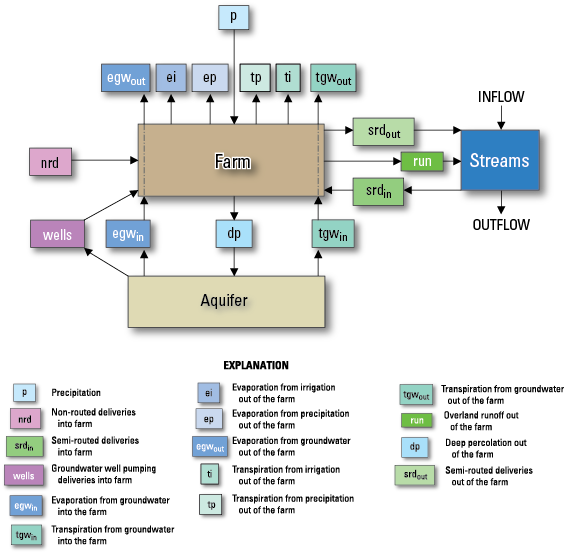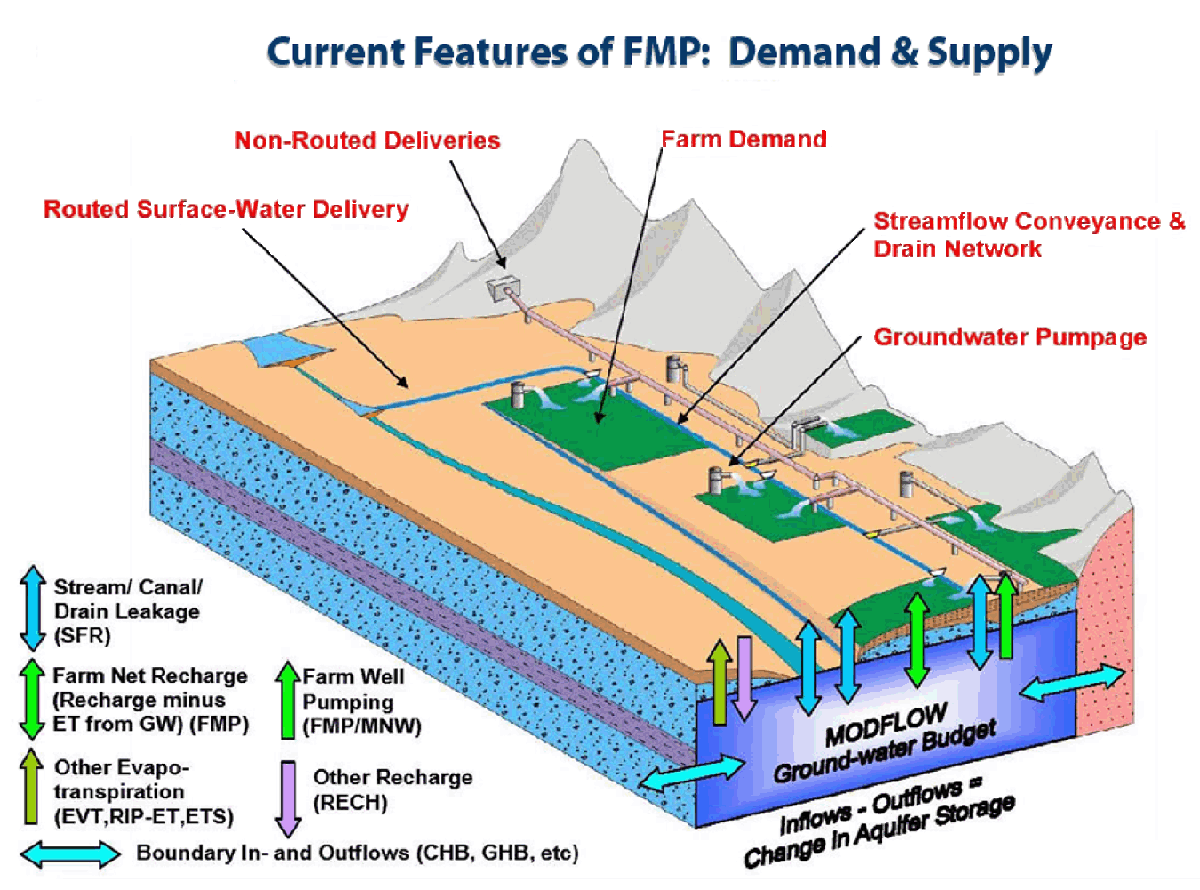California's Central Valley
Central Valley Hydrologic Model: Farm Process

Water inflows to and outflows from a "farm" as simulated by the Farm Process (FMP).
For the CVHM, the processes of evaporation, transpiration, runoff, and deep percolation to groundwater were estimated using the MODFLOW-FMP (Schmid and others, 2006a, b). The FMP allocates water, simulates or approximates processes, and computes mass balances for defined subregions of the model domain; in the CVHM, these subregions, or "farms," are defined as the Water Balance Subregions (WBSs).
The FMP was developed to estimate irrigation water allocations from conjunctively used surface water and groundwater. It is designed to simulate the demand components representing crop irrigation requirements and on-farm inefficiency losses, and the supply components representing surface-water deliveries and supplemental groundwater pumpage. The FMP also simulates additional head-dependent inflows and outflows such as canal losses and gains, surface runoff, surface-water return flows, evaporation, transpiration, and deep percolation of excess water.
The FMP is based on mass balances (Schmid and others, 2006a, b). A farm mass balance is maintained between all inflows to and outflows from a farm, and is calculated and balanced for each simulation time step. A soil-water balance is calculated between inflows into the soil zone and the ET outflow. The FMP dynamically integrates irrigation water demand, surface-water and groundwater supply, and deep percolation.
The FMP has the capability to estimate economically optimal allocations through acreage optimization of water supplied by surface-water and groundwater deliveries when demand exceeds supply. Other non-economic drought-response scenarios, such as deficit irrigation and water stacking, also are available.
For the purposes of this report, the WBS represents the basic accounting unit (farm) for water consumption. On the basis of cell-by-cell estimations for each WBS, the FMP first calculates crop-water demand as the transpiration from plant-water consumption and the related evaporation. The FMP then determines a residual crop-water demand that cannot be satisfied by precipitation and (or) by root uptake from groundwater. The FMP then equates this residual crop-water demand with the crop-irrigation requirement for the cells with irrigated crops (exclusive of any natural vegetation).
This crop irrigation requirement then is adjusted (increased) by accounting for evaporative losses from irrigation, and other losses owing to inefficiencies, to yield a final total farm delivery requirement (TFDR). The FMP first attempts to satisfy the TFDR using surface water. The surface water can be obtained from source water that is not simulated in the stream network, referred to as "non-routed," or from water routed through the stream network and delivered to a WBS, referred to as "semi-routed." The non-routed surface-water supply components have first priority and surface-water deliveries have second priority. Lastly, if the TFDR is not met using surface water, the FMP computes the amount of supplemental groundwater necessary to extract from "farm" wells in order to satisfy the TFDR. The amount of excess water from irrigation and (or) precipitation that is not evaporated or consumed for plant growth then becomes either overland runoff to nearby streams or groundwater recharge. As mentioned earlier, a soil-water balance is calculated between inflows into the soil zone and the ET outflow. Thus, the FMP dynamically links the demand, supply, and related change in aquifer-system storage. All of the supply and demand components then are tabulated into a WBS budget that complements the groundwater-flow budget.


 Model Datasets:
Model Datasets: Numerical Model Data files:
Numerical Model Data files: Texture Model Data files:
Texture Model Data files: